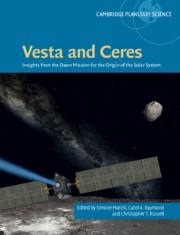Book contents
- Vesta and Ceres: Insights from the Dawn Mission for the Origin of the Solar System
- Cambridge Planetary Science
- Vesta and Ceres
- Copyright page
- Contents
- Contributors
- Preface
- Part I Remote Observations and Exploration of Main Belt Asteroids
- Part II Key Results from Dawn’s Exploration of Vesta and Ceres
- 3 Protoplanet Vesta and HED Meteorites
- 4 The Internal Evolution of Vesta
- 5 Geomorphology of Vesta
- 6 The Surface Composition of Vesta
- 7 Ceres’ Surface Composition
- 8 Carbon and Organic Matter on Ceres
- 9 Ammonia on Ceres
- 10 Geomorphology of Ceres
- 11 Ceres’ Internal Evolution
- 12 Geophysics of Vesta and Ceres
- Part III Implications for the Formation and Evolution of the Solar System
- Index
- Plate Section (PDF Only)
- References
7 - Ceres’ Surface Composition
from Part II - Key Results from Dawn’s Exploration of Vesta and Ceres
Published online by Cambridge University Press: 01 April 2022
- Vesta and Ceres: Insights from the Dawn Mission for the Origin of the Solar System
- Cambridge Planetary Science
- Vesta and Ceres
- Copyright page
- Contents
- Contributors
- Preface
- Part I Remote Observations and Exploration of Main Belt Asteroids
- Part II Key Results from Dawn’s Exploration of Vesta and Ceres
- 3 Protoplanet Vesta and HED Meteorites
- 4 The Internal Evolution of Vesta
- 5 Geomorphology of Vesta
- 6 The Surface Composition of Vesta
- 7 Ceres’ Surface Composition
- 8 Carbon and Organic Matter on Ceres
- 9 Ammonia on Ceres
- 10 Geomorphology of Ceres
- 11 Ceres’ Internal Evolution
- 12 Geophysics of Vesta and Ceres
- Part III Implications for the Formation and Evolution of the Solar System
- Index
- Plate Section (PDF Only)
- References
Summary
Ceres’ composition has been a long-standing issue since the first ground-based observations because of its peculiar spectrum and lack of an established connection with meteorites. NASA’s Dawn mission acquired unprecedented measurements of the surface of the dwarf planet Ceres, bringing a breakthrough in the comprehension of the mineralogy of the surface. Ceres’ surface is a mixture of ultra-carbonaceous material, Mg-phyllosilicates, NH4-phyllosilicates, carbonates, organics, Fe-oxides, and volatiles, as determined by remote sensing instruments onboard Dawn: Visible and InfraRed imaging spectrometer (VIR), Gamma Ray and Neutron Detector (GRAND), and the Framing Camera (FC). The average mineralogy of Ceres reveals a possible past global aqueous alteration. Regional variations of such materials unveil possible processing acting on large scales, both endogenous and exogenous. Local areas of Ceres surface, on a spatial scale of a few kilometers, present significant spectral variations with respect to the measured average spectrum, and thus significant variation on the inferred mineralogy. Most imply recent or ongoing geological activity involving upwelling of subsurface carbonate-rich and salt-rich brines (Occator crater and Ahuna Mons), organic material (Ernutet crater), hydrated carbonates, and water ice (Oxo and Juling craters). Global aqueous alteration and recent hydrothermal activity place Ceres among the most interesting targets in astrobiology.
- Type
- Chapter
- Information
- Vesta and CeresInsights from the Dawn Mission for the Origin of the Solar System, pp. 105 - 120Publisher: Cambridge University PressPrint publication year: 2022

